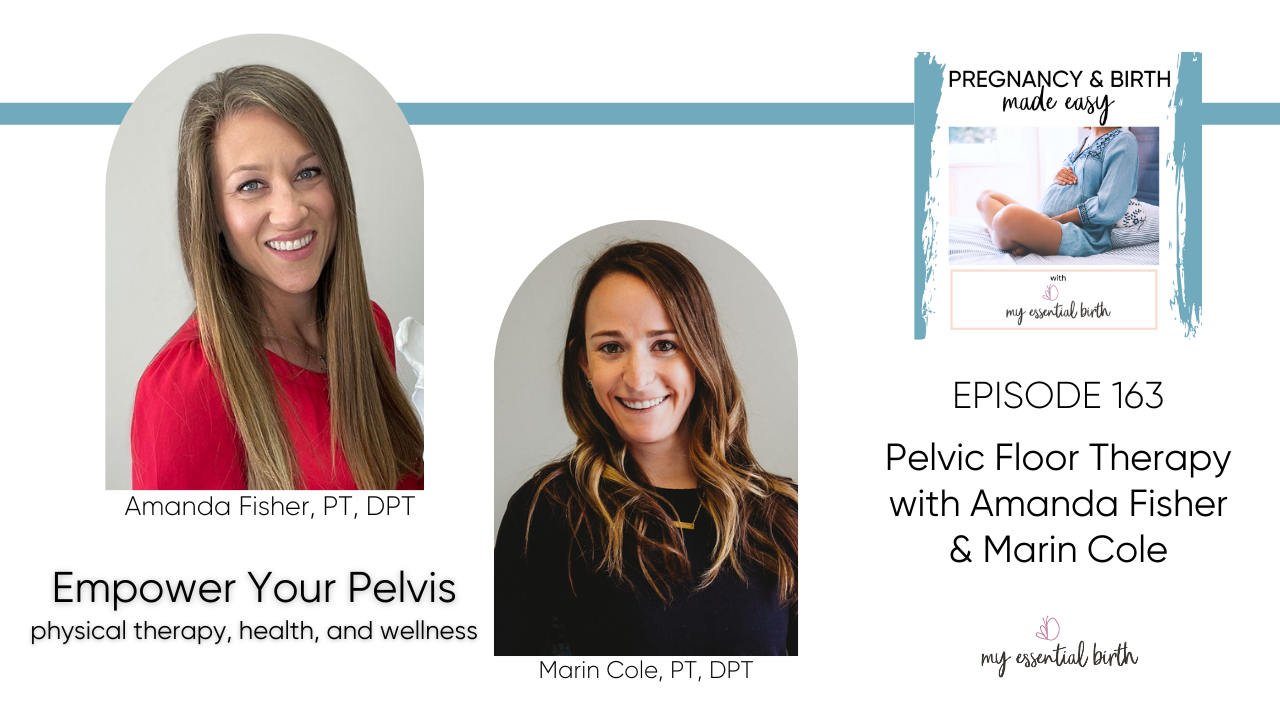Pelvic Floor Therapy with Amanda Fisher & Marin Cole

Show Notes:
[1:11] Our reviewer of the week is Courtney Clare, and she says: “I love this podcast so much, not only as a pregnant mama myself, but as a Registered Labor and Delivery Nurse! Stephanie does such a great job at covering ALL the relevant and important topics in digestible segments of information, and then turning that information into concrete resources and talking points for women to bring to their birth team. AND offers such a great balance of clinical and “crunchy.” Thank you for the work you do getting this essential information into the hands of moms everywhere!”
This week, I’m bringing even more evidence-based, excellent conversation today! Something we probably don’t spend enough time talking about is pelvic health during pregnancy and postpartum. If you’re anything like me, even with all of my study of birth, you may not even know that pelvic floor therapists are a thing. Well, lucky for you . . . that’s about to change! I have two pelvic floor therapists with me today, and we’re going to dive into information you need to know and can use right now!
[2:55] Amanda Fisher & Marin Cole introduce themselves. Amanda is the creator of Empower Your Pelvis, which is located in Kansas City, MO. Both have their doctorates in Physical Therapy. 👩🏼⚕️👩🏽⚕️
[6:20] Marin shares about how her own pregnancy has inspired her to empower women differently and treat their issues more specifically. She feels that she can now speak to her patients with more emphasis because of her experience. 🤰🏽
[8:24] Marin also encourages her patients to advocate for themselves, something she learned through reading and through the My Essential Birth podcast! 🙌🏼
[9:03] Amanda’s biggest takeaway from having three pregnancies herself: she realized that new moms are so overwhelmed that she changed the way she assigned exercises and focused more on “functional” motherhood. 🤱🏼
[9:40] Functional motherhood looks like squatting (picking up laundry), hinging (getting baby out of crib), pushing and pulling (bring baby towards us or putting them in the bassinet), farmer’s carry (how you hold the baby). When they’re doing certain activities, they can do specific exercises that they’re already subconsciously doing! 🧺👶🏻
[11:29] What is pelvic floor therapy? 🤔 The pelvic floor holds back but also releases urine, gas, and bowel movements. They hold organs (bladder, bowels, and uterus), support movement without any pain or disfunction, allow orgasms and intercourse, and work with the diaphragm.
[12:26] Is it normal to pee your pants after a baby? 😳 It is common, but your pelvic floor should be holding that in until you tell your body to release it.
[13:35] What kind of training do you need as a pelvic floor therapist? They obtain their doctorate in physical therapy. However, in school, they were only given a short lecture on where the pelvic floor is and when to refer out. After graduation, they can either take basic courses, or they can start specializing and take courses in diastasis, nerve pain, infertility, endometriosis, etc. They can also be certified in a pregnancy and postpartum specialty. 📝
[15:57] Quick commercial break! Empower Your Pelvis also has a podcast, where women can receive information on pelvic floor therapy, and see if it’s something they need to look into for themselves! 🎙
[17:04] I was so interested in the fact that fertility is something that can be addressed when it comes to pelvic floor health. Amanda speaks on how there have been studies that show pelvic floor exercises combined with fertility treatments increase the chances of becoming pregnant! 🤯
[19:15] When do mamas go see a pelvic floor therapist? Once they start to feel pain or do they come as a preventative measure? Marin said they usually see people when they are in pain or already having issues (pubic pain, back pain, pain with sex, etc.) They do love when patients come in as a preventative measure. 🥰
[22:07] They also see women with vulvar varicosities, which is described as pressure “down there.” 😖 She feels for women experiencing this because it’s so uncomfortable and painful. Amanda speaks on their recommendations for women who come in with varicosities.
[26:58] Let’s talk about kegels! 💪🏼 It’s important to work those muscles, but it’s important to learn how to control the motion of coming back down to release. Amanda and Marin talk about how to do kegels correctly and how they can help women.
[32:00] Amanda helps us visualize the different types of muscles and how they work together during pregnancy. Educating women on what muscles to “work out” for birth is so important! 🥤
[34:45] Core strength. Your abs will stretch as your belly stretches. As your abs stretch out, they will weaken. Training the muscles early will help mamas during and after pregnancy. Marin touches on diastasis recti, and how they can help. 🏋🏼♀️
[37:39] Every woman’s body is different! There are so many factors that play into your pregnancy and postpartum journey! 💕
[39:07] Breathing is extremely important because when you inhale, your diaphragm contracts down and the pelvic floor lengthens. The opposite occurs when you exhale. Marin talks about why breathing is essential when it comes to pelvic floor health. 😮💨
[43:00] Amanda talks about four things you should look for when trying to get back into your routine. Are you having increased bleeding, pressure, leakage, or pain? If so, your body is telling you that you’re taking it too far, and you need to modify your activity. 🏃🏼♀️
[43:48] Your breathing can help calm down your nervous system. Your pelvic muscles are the first muscles to go into tension and protection mode when your body is in pain (like during childbirth!) Belly breathing helps your pelvic floor to stretch and allow you to birth your baby. 😤
[44:48] For birth and labor prep, remember that pregnancy is a nine-month training for labor. You can control what happens up until delivery. Once you get to delivery, there are multiple paths and you have no control over the outcome. 👏🏼 You can only control your preparation and training. 👏🏼
[47:20] We need to look at the big picture of healing after birth and not be so focused on the “6-weeks” after birth. 🗓
[48:25] Another hot topic is perineal massage. Marin speaks on exercises to do to prepare during pregnancy. She also talks about perineal massage and the benefits of it for women who already have pelvic pain. It won’t prevent tearing, but it will help limit the severity and aid in the healing. ❤️🩹
[51:59] A key element in perineal massage is connecting to the tissues before birth mentally and physically. I teach breathing and release, but the idea of connecting is so helpful! 🧘🏼♀️
[52:55] There are many ways a pelvic therapist can help women. Where can I find other pelvic therapists? Amanda recommends a website for finding therapists, but she also emphasizes the importance on asking how they train and questions to ask. 💻
[55:02] They are providing a free PDF of the “Top 3 Pregnancy Stretches for Your Pelvic Floor.” 🤩 On the handout, they have directions on how to do the stretches. You can find Amanda and Marin in the links below!
To Leave a Review ⭐️
- Open Apple Podcasts
- Find “Pregnancy & Birth Made Easy” podcast
- Select “Ratings and Reviews”
- Click the stars!
- Select “Write a Review” and tell us what was the most amazing, comforting, eye-opening thing that you loved!
ALL the best,

Links Mentioned:
Empower Your Pelvis Free PDF - Top 3 Pregnancy Stretches for Your Pelvic Floor
Empower Your Pelvis Social Media Links:

